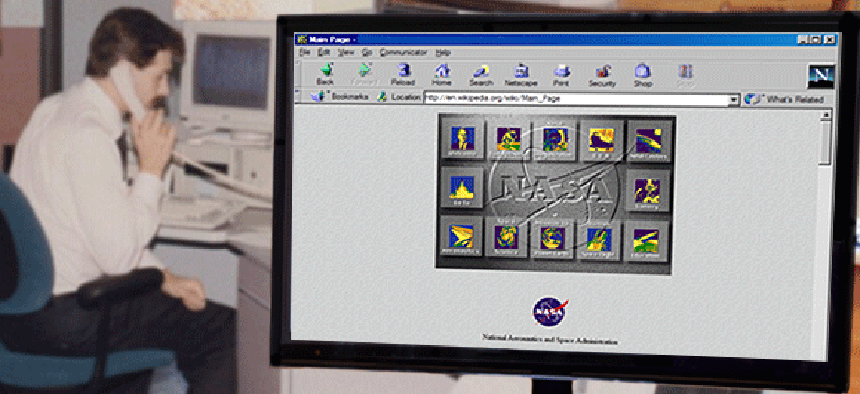Shutdown fallout: Government online like it's 1999

Staff cutbacks as a result of the federal government shutdown have put agency websites into the Wayback Machine.
The partial shutdown of the federal government resulting from Congress’ budget impasse has put some 800,000 employees on the couch, closed national parks and put a hold on services ranging from processing FOIA requests to administering flu shots.
And it also has thrown government’s online presence backward in time. If it seems hard to remember when agencies had only static websites, or no websites at all, now’s your chance for a trip through history.
The most noticeable absence is that of NASA, which to date has developed a more engaging, educational and entertaining Web presence than perhaps any other agency. NASA has furloughed 98 percent of its workforce, just about everyone other than those working at Mission Control for the International Space Station, so along with its research work, the agency’s website has gone dark. Try to go to nasa.gov and all you get is a message on USA.gov apologizing for the site’s unavailability.
Anyone who wants to play one of NASA’s online games or see satellite views of Earth and the stars are out of luck too. If you want to check in on the progress of the Mars Rover, you can wait to see if Walter Cronkite has anything on it at 6.
The Library of Congress’s main website also turns up the same message that NASA’s does, although its legislative tracker THOMAS is up. Not that it has much to report. Also closed is the Federal Trade Commission’s site.
Most government websites, however, aren’t stuck in the pre-Internet days. They’re more in the early-Internet days, with websites that appear in the browser but are largely static. The Federal Election Commission’s site, for example, is up but will go without updates during the shutdown (all but six of its 346 employees are furloughed). Likewise the Federal Communications Commission and Equal Employment Opportunity Commission, both of whose offices, while minimally staffed, are closed. A notice on the Energy Department website notes that DOE’s websites are accessible, “but may not be updated until Congress authorizes funds for Fiscal Year 2014.” That includes sites such as ARPA-E, the department’s cutting-edge research arm.
Others, such as that of the mostly operational Veterans Affairs Department, may have only occasional updates.
The National Park Service’s website is up, even if the parks themselves are closed, so there’s no need to advertise park events or take campground reservations. And while you can get to the Smithsonian’s National Zoo website, its live animal cameras, including the popular panda cam, aren’t available.
Even sites that are providing services have cut them to a minimum. The Treasury Department and IRS sites are up, but their services have been reduced to a low level. The State Department says it will keep passport agencies operational as long as possible, but it said there could be some lapses.
The lack of online services, of course, is a symptom of agencies cutting back on services overall. FOIA requests, for instance, will be accepted but not processed. The Centers for Disease Control and Prevention won’t be running its seasonal flu vaccination program (though its Vaccines for Children program, which gets mandatory funding, will continue), and the agency will be very limited in its ability to track the spread of diseases, according to its shutdown plan.
CNN has an agency-by-agency list of the cutbacks and furloughs.
How long Congress will keep government unfunded is anybody’s guess, as of this writing. The last shutdown lasted 21 days across 1995 and ’96. Meanwhile, agencies will scuffle along with whatever manpower they have, and people will do without online interactions and services they’ve come to take for granted.
If you want to know what online government was like in the early days, you could try the Wayback Machine, or you could just take a look at what’s currently available.





